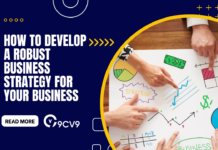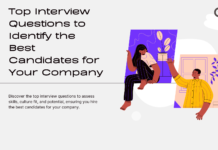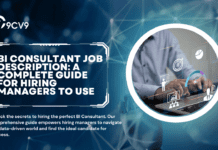Key Takeaways
- High-performing workforces are defined by productivity, collaboration, adaptability, and consistent goal achievement.
- Building such teams requires strong leadership, continuous learning, clear KPIs, and supportive culture.
- Leveraging modern tools and platforms like 9cv9 enhances recruitment, performance tracking, and workforce sustainability.
In today’s hyper-competitive business environment, organizations across industries are constantly seeking new ways to gain an edge. While technology, innovation, and market strategy all play critical roles, one factor stands above the rest in determining long-term success: people. More specifically, the quality and performance of the workforce. A high-performing workforce isn’t just a desirable asset—it’s a vital necessity for companies that aim to stay ahead of the curve, achieve sustainable growth, and build a resilient organizational culture.

But what exactly is a high-performing workforce? In simple terms, it refers to a group of employees who consistently exceed expectations, demonstrate strong collaboration, deliver results with efficiency, and are fully aligned with the company’s vision and values. These teams thrive on mutual accountability, clear communication, continuous improvement, and a shared commitment to excellence. They not only meet organizational goals but often surpass them, driving innovation and inspiring others in the process.
However, cultivating such a workforce is not something that happens by chance. It requires intentional effort, strategic planning, and a deep understanding of what motivates and empowers people. Businesses must go beyond just hiring top talent; they need to foster a workplace culture that promotes trust, learning, feedback, and recognition. Leadership plays a crucial role, as do well-defined performance metrics, employee engagement initiatives, and access to the right tools and resources.
Moreover, in a landscape where remote and hybrid work models are becoming the norm, the dynamics of team performance are evolving. Companies must now adapt their strategies to build high-performing teams that are not only productive but also agile, innovative, and resilient to change. This involves embracing new technologies, redefining performance management practices, and prioritizing employee well-being as part of the performance equation.
In this comprehensive guide, we will delve into what defines a high-performing workforce, explore its benefits, outline the common challenges organizations face, and provide actionable strategies to create and sustain high-performance teams. Whether you’re an HR leader, a business owner, or a manager seeking to elevate your team’s capabilities, this blog will offer valuable insights to help you build a workforce that consistently delivers results and drives lasting success.
Before we venture further into this article, we would like to share who we are and what we do.
About 9cv9
9cv9 is a business tech startup based in Singapore and Asia, with a strong presence all over the world.
With over nine years of startup and business experience, and being highly involved in connecting with thousands of companies and startups, the 9cv9 team has listed some important learning points in this overview of What is a High-Performing Workforce and How To Create One.
If your company needs recruitment and headhunting services to hire top-quality employees, you can use 9cv9 headhunting and recruitment services to hire top talents and candidates. Find out more here, or send over an email to [email protected].
Or just post 1 free job posting here at 9cv9 Hiring Portal in under 10 minutes.
What is a High-Performing Workforce and How To Create One
- What is a High-Performing Workforce?
- Key Traits of a High-Performing Workforce
- Benefits of Building a High-Performing Workforce
- Common Challenges in Creating a High-Performing Team
- How to Build and Sustain a High-Performing Workforce
- Tools and Technologies to Support High Performance
- Future Trends in Workforce Performance
1. What is a High-Performing Workforce?
A high-performing workforce refers to a group of employees who consistently deliver superior results, collaborate effectively, and contribute meaningfully to the strategic goals of the organization. These employees not only meet performance expectations but often exceed them through high engagement, adaptability, and innovation.
1. Key Characteristics of a High-Performing Workforce
A high-performing workforce typically exhibits the following traits:
a. Aligned with Organizational Goals
- Clear understanding of the company’s vision and mission
- Employees see how their roles impact broader objectives
- Goal setting is SMART (Specific, Measurable, Achievable, Relevant, Time-bound)
b. Strong Communication and Collaboration
- Teams operate with transparency and open dialogue
- Minimal communication silos between departments
- Use of collaboration tools like Slack, Microsoft Teams, or Asana
c. Ownership and Accountability
- Employees take responsibility for results and outcomes
- Managers encourage self-leadership and initiative
- Mistakes are seen as learning opportunities
d. Commitment to Continuous Improvement
- Employees seek regular upskilling and feedback
- Adoption of a growth mindset is prevalent across the team
- Participation in training programs, workshops, and certifications
e. High Levels of Engagement and Motivation
- Intrinsic and extrinsic motivators are understood and utilized
- Low absenteeism and high retention rates
- Active participation in team events and organizational initiatives
2. High-Performing Workforce vs. Average Workforce
| Attribute | High-Performing Workforce | Average Workforce |
|---|---|---|
| Goal Alignment | Strong alignment with company objectives | Limited understanding of company goals |
| Communication | Transparent, proactive, and consistent | Siloed or inconsistent communication |
| Innovation | Actively contributes new ideas and solutions | Follows instructions with limited innovation |
| Engagement | Highly engaged and invested in outcomes | Disconnected or passive involvement |
| Productivity | Exceeds performance benchmarks regularly | Meets minimum performance expectations |
| Collaboration | Works seamlessly across teams and functions | Focuses on individual tasks |
| Learning & Development | Continuously learning and adapting | Minimal participation in training |
3. Real-World Examples of High-Performing Workforces
Example 1: Google
- Known for building teams based on “psychological safety”
- Encourages experimentation, continuous feedback, and data-driven decisions
- Offers tailored development programs and employee autonomy
Example 2: Toyota
- Uses the Kaizen (continuous improvement) philosophy
- Every employee is empowered to suggest process improvements
- Workforce is trained in lean manufacturing and team collaboration
Example 3: Atlassian
- Promotes a culture of radical transparency and trust
- Utilizes collaborative tools for global team integration
- Regular hackathons and innovation sprints to boost performance
4. Common Roles and Their High-Performance Indicators
| Role | High-Performance Behaviors |
|---|---|
| Sales Executive | Exceeds targets, nurtures long-term clients, adapts quickly |
| Software Developer | Writes clean, scalable code, participates in code reviews |
| HR Manager | Develops talent pipelines, champions company culture |
| Customer Service Rep | Resolves issues fast, gets high satisfaction scores |
| Marketing Manager | Delivers high-ROI campaigns, drives brand engagement |
5. The High-Performance Culture Matrix
A useful framework to assess your workforce readiness for high performance is the High-Performance Culture Matrix:
| Engagement Level | Performance Level | Outcome | Action Needed |
|---|---|---|---|
| High Engagement | High Performance | Peak performers driving company growth | Recognize and retain |
| High Engagement | Low Performance | Motivated but under-skilled | Upskill and mentor |
| Low Engagement | High Performance | Risk of burnout or attrition | Re-engage and support |
| Low Engagement | Low Performance | Major risk to productivity and culture | Reassess role fit or rehire |
6. Metrics Used to Identify a High-Performing Workforce
Track these key metrics to assess the level of workforce performance:
- Productivity per Employee
Measures output relative to resources used - Employee Engagement Score
Derived from surveys, turnover rates, and feedback - Goal Completion Rate
Percentage of business goals achieved on time - Skill Utilization Rate
How effectively employees use their competencies - Managerial Effectiveness
Performance of leaders in enabling team success - Innovation Index
Number of new ideas implemented or process improvements initiated
7. Signs Your Workforce is High-Performing
- Consistently exceeds KPIs and OKRs
- Voluntary sharing of knowledge and best practices
- High participation in learning and development initiatives
- Minimal internal conflicts and healthy team dynamics
- Employees actively contribute during meetings and brainstorming sessions
- Quick adaptability to market or operational changes
2. Key Traits of a High-Performing Workforce
A high-performing workforce consistently delivers exceptional results by combining talent, collaboration, motivation, and strategic alignment. These teams are distinguished not just by what they achieve, but by how they work together, solve problems, and grow over time.
1. Strategic Goal Alignment
High-performing teams clearly understand their individual contributions to broader organizational success.
Key Characteristics
- Clear understanding of company mission and vision
- Roles and responsibilities tied to strategic objectives
- Regular performance check-ins linked to company KPIs
Example
At Salesforce, employees set V2MOMs (Vision, Values, Methods, Obstacles, and Measures) to align daily work with corporate strategy.
Visual: Goal Alignment Chart
| Level | Key Activities | Tools Used |
|---|---|---|
| Executive | Sets vision and corporate goals | OKRs, Balanced Scorecard |
| Department | Aligns team objectives with corporate strategy | Departmental OKRs |
| Individual | Sets personal goals tied to team performance | SMART Goals, KPIs |
2. High Accountability and Ownership
Each member of a high-performing workforce takes full responsibility for outcomes, not just actions.
Key Characteristics
- Proactive attitude toward tasks and deadlines
- Willingness to admit mistakes and learn from them
- Takes initiative without being micromanaged
Example
At Netflix, the corporate culture encourages freedom with responsibility—trusting employees to make smart decisions with accountability.
Ownership Matrix
| Behavior | Low-Performing Teams | High-Performing Teams |
|---|---|---|
| Task Responsibility | Shifts blame | Owns outcomes |
| Decision-Making | Waits for direction | Acts proactively |
| Mistake Management | Hides or downplays errors | Acknowledges and corrects |
| Initiative | Completes only assigned work | Suggests improvements |
3. Effective Communication and Collaboration
High-performing teams are built on transparent, respectful, and frequent communication.
Key Characteristics
- Open feedback loops between employees and leaders
- Active listening during team interactions
- Collaborative tools and regular stand-up meetings
Example
At Atlassian, regular “Team Health Check” surveys help assess collaboration and communication, with teams making iterative improvements.
Collaboration Tools Comparison Table
| Tool | Primary Use | Used By |
|---|---|---|
| Slack | Real-time messaging | Tech, HR, Marketing |
| Microsoft Teams | Video + text collaboration | Corporate, enterprise teams |
| Asana/Trello | Project/task management | Operations, product development |
| Miro | Brainstorming, whiteboarding | Design, strategy, remote teams |
4. Culture of Continuous Learning
A high-performing workforce embraces learning as an ongoing process rather than a one-time event.
Key Characteristics
- Encouragement to pursue certifications and upskilling
- Regular internal training and knowledge-sharing sessions
- Culture that rewards curiosity and experimentation
Example
Amazon promotes a “Learn and Be Curious” leadership principle, offering programs like Machine Learning University for continuous upskilling.
L&D Channels Used by Top Companies
| Type of Learning | Platform Examples | Skills Gained |
|---|---|---|
| Online Courses | Coursera, Udemy, LinkedIn Learning | Tech, business, leadership |
| Internal Knowledge Sharing | Wikis, townhalls, brown bags | Domain knowledge, process knowledge |
| Mentorship Programs | Buddy systems, coaching platforms | Leadership, onboarding, soft skills |
5. Innovation and Problem-Solving
High-performing teams are not just efficient—they are also innovative and solution-oriented.
Key Characteristics
- Willingness to challenge status quo
- Encourages experimentation and iteration
- Focused on root-cause analysis, not just surface-level fixes
Example
Toyota implements a company-wide Kaizen (continuous improvement) system where all employees are encouraged to contribute improvement ideas, no matter how small.
Problem-Solving Framework: The 5 Whys
| Step | Action | Example (Late delivery) |
|---|---|---|
| 1st Why | Why was the delivery late? | Truck broke down |
| 2nd Why | Why did the truck break down? | Missed maintenance |
| 3rd Why | Why was maintenance missed? | Schedule wasn’t followed |
| 4th Why | Why wasn’t it followed? | No system reminders |
| 5th Why | Why no reminders? | No software or protocol in place |
6. Employee Engagement and Morale
Highly engaged employees perform better, stay longer, and serve customers more effectively.
Key Characteristics
- Positive emotional connection to the organization
- Recognition and reward systems in place
- Empowered to make decisions and influence change
Example
Zappos fosters engagement through employee-led events, flexible work environments, and strong cultural alignment.
Gallup Engagement Levels
| Engagement Level | Description | Percentage in High-Performing Companies |
|---|---|---|
| Highly Engaged | Emotionally invested in work and company success | 70%+ |
| Moderately Engaged | Do their job but lack emotional commitment | 20–25% |
| Actively Disengaged | Unhappy and undermining productivity | <5% |
7. Resilience and Adaptability
High-performing workforces can quickly adapt to change, uncertainty, and evolving business needs.
Key Characteristics
- Embrace agile workflows and flexible thinking
- Handle crises with composure and proactivity
- Thrive in both in-office and remote environments
Example
During the pandemic, Spotify introduced its “Work From Anywhere” model to enhance adaptability and retain top talent.
Adaptability Traits Checklist
- Flexible roles and responsibilities
- Cross-functional collaboration
- Supportive leadership in change management
- Use of agile methodologies
- Rapid decision-making with decentralized input
8. Trust and Psychological Safety
A foundation of mutual trust enables employees to take risks, express ideas, and challenge assumptions without fear.
Key Characteristics
- Safe environment for idea sharing and dissent
- Leadership models vulnerability and openness
- Constructive conflict resolution practices
Example
Google’s Project Aristotle found that psychological safety was the most critical factor in high team performance.
Psychological Safety Assessment (Sample Scale)
| Statement | Rating (1–5) |
|---|---|
| I can take risks on this team without fear. | |
| My unique skills and talents are valued here. | |
| Mistakes are treated as learning opportunities. | |
| Everyone’s opinion is considered in decisions. |
3. Benefits of Building a High-Performing Workforce
Creating a high-performing workforce delivers measurable and strategic advantages across every level of the organization. These benefits go far beyond improved productivity—they enhance innovation, employee satisfaction, customer loyalty, and overall business competitiveness. Companies that prioritize workforce excellence often outperform their competitors in both financial performance and market reputation.
1. Enhanced Productivity and Efficiency
High-performing teams complete more work with fewer resources and in less time, leading to stronger ROI.
Key Benefits
- Faster task and project completion
- Reduced bottlenecks and downtime
- Streamlined workflows and leaner operations
- Higher output per employee
Example
Toyota’s lean manufacturing system demonstrates how empowering employees to eliminate waste results in faster production cycles and higher efficiency.
Table: Productivity Impact Comparison
| Factor | Low-Performing Workforce | High-Performing Workforce |
|---|---|---|
| Average Task Completion | Delayed | Ahead of schedule |
| Resource Utilization | Inefficient | Optimized |
| Rework Frequency | High | Low |
| Team Output | Inconsistent | Predictable and scalable |
2. Increased Innovation and Creativity
High-performing teams are often the engine of innovation in modern enterprises.
Key Benefits
- Employees contribute new ideas and process improvements
- Greater participation in R&D and brainstorming initiatives
- Innovation is embedded into daily tasks and culture
- Faster product development and market adaptability
Example
3M allows employees to spend 15% of their time on personal innovation projects. This culture led to the invention of the Post-it Note and numerous other innovations.
Innovation Contribution Matrix
| Innovation Source | Impact in High-Performing Teams |
|---|---|
| Frontline Employees | Suggest process and UX improvements |
| Middle Management | Identify inefficiencies and growth areas |
| Leadership | Drives vision-aligned innovation |
| Cross-Functional Teams | Co-create new solutions and products |
3. Higher Employee Retention and Reduced Turnover
When employees are empowered and engaged, they are far more likely to stay and grow within the company.
Key Benefits
- Reduced recruitment and training costs
- Lower absenteeism and turnover rates
- Stronger internal promotion pipelines
- Higher organizational loyalty and morale
Example
HubSpot invests heavily in employee development and transparency, which helped it achieve one of the highest employee retention rates in the SaaS industry.
Employee Retention Comparison Table
| Metric | Average Workforce | High-Performing Workforce |
|---|---|---|
| Annual Turnover Rate | 20–35% | 5–10% |
| Internal Promotion Rate | Low | High |
| Absenteeism Rate | High | Low |
| Employee Engagement Score | Below 60% | Above 80% |
4. Improved Customer Satisfaction and Loyalty
Happy, high-performing employees tend to create better customer experiences—leading to stronger customer loyalty and advocacy.
Key Benefits
- Faster response times and accurate service delivery
- Greater empathy and customer problem-solving
- Higher Net Promoter Scores (NPS)
- Long-term customer retention and upsell opportunities
Example
Zappos empowers every employee to go above and beyond for customers without rigid scripts or restrictions, resulting in exceptional customer satisfaction metrics.
Visual: Employee Performance to Customer Satisfaction Flowchart
javaCopyEditHigh Employee Engagement
↓
Better Collaboration & Communication
↓
Faster & Friendlier Customer Interaction
↓
Increased Customer Satisfaction (CSAT) & Loyalty
5. Stronger Organizational Agility and Resilience
High-performing workforces adapt quickly to change, enabling the business to thrive even in uncertain times.
Key Benefits
- Faster pivoting in response to market shifts
- Teams function effectively in hybrid/remote models
- Increased comfort with ambiguity and risk-taking
- Quicker recovery from setbacks and disruptions
Example
During the COVID-19 pandemic, Spotify implemented its “Work from Anywhere” model, allowing teams to remain productive and collaborative despite major operational changes.
Resilience Assessment Grid
| Resilience Factor | Description | High-Performing Teams Outcome |
|---|---|---|
| Change Readiness | Preparedness for structural changes | High |
| Response Time to Disruption | Time to shift or recover | Fast |
| Cross-Training & Versatility | Team member adaptability | Broad skill coverage |
| Emotional Stability | Stress handling and focus | Strong and proactive |
6. Higher Profitability and ROI
When all other benefits—productivity, innovation, retention, customer satisfaction—align, the financial outcomes are significant.
Key Benefits
- Higher revenue per employee
- Greater profitability due to efficiency and reduced waste
- Better cost management across departments
- Accelerated return on investment in talent development
Example
According to a study by Gallup, companies with high employee engagement outperform their competitors by 21% in profitability and 17% in productivity.
Table: Financial Impact of High-Performing Workforce
| Metric | Low-Performing Workforce | High-Performing Workforce |
|---|---|---|
| Revenue per Employee | $150,000 | $250,000+ |
| Cost of Turnover | High | Low |
| Profit Margins | 8–12% | 15–25% |
| ROI on Training & Development | < 50% | 120%+ |
7. Enhanced Employer Brand and Talent Attraction
A high-performing workforce becomes a company’s most powerful recruitment tool, drawing in top-tier talent organically.
Key Benefits
- Improved company reputation in the job market
- Higher quality candidate pools
- Increased employee referrals
- Reduced time-to-hire and cost-per-hire
Example
Google’s well-known culture of excellence and performance attracts millions of applicants yearly, allowing them to choose the best-fit candidates with minimal external marketing.
Employer Branding Impact Metrics
| Metric | Average Companies | High-Performing Companies |
|---|---|---|
| Qualified Applicants per Role | 20–30 | 100+ |
| Employee Referral Rate | 10–15% | 35–50% |
| Time to Fill | 40–60 days | 20–30 days |
| Offer Acceptance Rate | 65–75% | 90%+ |
8. Better Team Morale and Workplace Culture
When employees feel valued and empowered, the entire company culture becomes more supportive, inclusive, and driven.
Key Benefits
- Higher teamwork and mutual respect
- Reduced workplace conflict
- Greater diversity of thought and participation
- Culture becomes a competitive asset
Example
Salesforce invests in equality initiatives, employee well-being, and leadership transparency—leading to strong employee morale and one of the most admired corporate cultures globally.
Team Morale Indicators Chart
| Cultural Element | Effect on High-Performing Workforce |
|---|---|
| Psychological Safety | Encourages openness and feedback |
| Diversity and Inclusion | Brings broader ideas and innovation |
| Transparency from Leadership | Builds trust and credibility |
| Recognition Programs | Reinforces high performance and motivation |
4. Common Challenges in Creating a High-Performing Team
While the benefits of a high-performing team are undeniable, the journey to building one is filled with practical, cultural, and operational hurdles. Organizations must proactively identify and overcome these challenges to unlock peak workforce performance. Understanding these obstacles is the first step toward creating sustainable high-performance dynamics.
1. Lack of Clear Vision and Goal Alignment
Without a unified direction, even the most talented individuals will struggle to perform effectively as a team.
Key Challenges
- Ambiguous company mission or departmental objectives
- Misalignment between leadership goals and frontline execution
- Lack of individual goal clarity or prioritization
Example
A mid-sized software firm experienced repeated project delays because teams lacked clarity on whether to prioritize user experience or technical scalability. Only after aligning product, design, and engineering around a shared goal did productivity improve.
Symptoms of Poor Alignment
| Area | Indicators |
|---|---|
| Task Prioritization | Teams work on conflicting deliverables |
| Performance Reviews | Misaligned expectations across managers |
| Employee Morale | Confusion and frustration among teams |
| Strategic Outcomes | Delayed or missed KPIs |
2. Ineffective Leadership or Management
Leaders who lack the skills to inspire, align, or enable teams can become major roadblocks.
Key Challenges
- Poor delegation and micro-management
- Failure to coach or develop team members
- Lack of transparency or inconsistent communication
- Inability to resolve conflict or promote inclusivity
Example
In a large retail company, middle managers were not trained to manage remote teams. As a result, communication broke down and morale dropped, until leadership implemented targeted training in remote team engagement and performance coaching.
Leadership Performance Matrix
| Leadership Style | Effect on Team Performance |
|---|---|
| Transformational | Boosts innovation, ownership, and morale |
| Transactional | Effective short-term, limited long-term growth |
| Autocratic | Stifles collaboration and engagement |
| Laissez-faire | Leads to confusion and performance gaps |
3. Poor Communication and Collaboration
Ineffective communication breeds misunderstandings, delays, and fractured team dynamics.
Key Challenges
- Information silos between departments or teams
- Infrequent or unclear communication from leadership
- Lack of feedback culture or structured collaboration tools
- Remote and hybrid work adding complexity to interactions
Example
A digital marketing agency saw campaign failures due to isolated teams working without shared updates. Implementing shared dashboards and daily stand-ups resolved coordination issues and improved delivery speed.
Chart: Communication Effectiveness Curve
yamlCopyEditCommunication Frequency → (X-axis)
Team Understanding & Output → (Y-axis)
Low frequency: Confusion → Moderate: Alignment → High: Productivity → Excessive: Fatigue
4. Resistance to Change
Even with clear goals and vision, cultural resistance can prevent teams from evolving or adopting performance-enhancing practices.
Key Challenges
- Employees accustomed to legacy systems or methods
- Fear of job loss due to automation or restructuring
- Lack of communication around the “why” behind changes
- Inadequate change management strategies
Example
When a multinational bank introduced a digital workflow platform, employees initially refused to use it, fearing job loss. After conducting transparent workshops and providing retraining, usage and acceptance improved significantly.
Change Readiness Assessment Grid
| Readiness Factor | Low-Performing Team | High-Performing Team |
|---|---|---|
| Openness to New Tools | Low | High |
| Willingness to Upskill | Resistant | Eager |
| Change Leadership Support | Absent | Strong |
| Communication About Change | Minimal | Proactive and ongoing |
5. Skills Gaps and Talent Mismatch
Having team members who lack critical skills or are in the wrong roles directly affects overall team effectiveness.
Key Challenges
- Misaligned hiring practices or unclear job roles
- Lack of investment in employee upskilling and reskilling
- Limited access to learning resources or mentorship
- Technical or soft skill deficits within teams
Example
An AI startup had talented engineers but lacked strong project managers. As a result, delivery timelines slipped. By hiring for project management and implementing mentorship, execution and output improved.
Skills Gap Heat Map (Sample)
| Skill Area | Importance | Team Proficiency | Gap Level |
|---|---|---|---|
| Data Analysis | High | Moderate | Medium |
| Communication | High | Low | High |
| Agile Methodology | Medium | High | Low |
| Time Management | High | Low | High |
6. Lack of Recognition and Motivation
Without regular appreciation or motivation, even high performers may disengage or underperform.
Key Challenges
- No structured recognition or reward programs
- Inconsistent feedback or praise from managers
- Employees feel undervalued or invisible
- Overemphasis on weaknesses instead of strengths
Example
At a fintech firm, quarterly surveys showed declining engagement. Employees cited a lack of appreciation as the main reason. Introducing a peer-to-peer recognition program raised engagement scores by 30%.
Motivation Framework: Herzberg’s Two-Factor Model
| Hygiene Factors | Motivators |
|---|---|
| Salary | Achievement and recognition |
| Job security | Growth and advancement opportunities |
| Work conditions | Purposeful and meaningful work |
| Policies | Autonomy and personal development |
7. Toxic Workplace Culture
Even with good systems, a toxic work culture can destroy collaboration, trust, and innovation.
Key Challenges
- Favoritism or workplace politics
- Lack of inclusivity and psychological safety
- Harassment or discrimination issues
- Gossip, blame culture, and fear of speaking up
Example
A design firm lost top talent due to internal cliques and politics. Post-audit, they enforced new leadership, introduced anonymous feedback channels, and rebuilt a more open culture that improved retention.
Toxic Culture Warning Signs Checklist
- High employee turnover
- Frequent internal conflicts or complaints
- Low engagement in team meetings
- Fear of voicing dissent or feedback
- Absenteeism or burnout trends
8. Inconsistent Performance Management Systems
If performance reviews and goal-setting are inconsistent, employee growth becomes stagnant and demotivating.
Key Challenges
- Annual reviews with no ongoing feedback
- Subjective or biased performance evaluations
- No linkage between performance and rewards
- Lack of individual development plans
Example
A global logistics company switched from annual reviews to continuous feedback using a performance management platform. As a result, productivity improved by 18% and turnover dropped by 25%.
Table: Performance Review Models Comparison
| Model | Frequency | Effectiveness | Best for |
|---|---|---|---|
| Annual Review | Once a year | Low for agility | Traditional workplaces |
| Quarterly Reviews | 4x per year | Moderate | Goal-driven organizations |
| Continuous Feedback | Weekly/monthly | High | Fast-paced or innovative teams |
9. Over-Reliance on Top Performers
Dependence on a few star employees can create team imbalance, bottlenecks, and burnout.
Key Challenges
- Unequal workload distribution
- Dependency on “hero” employees
- Neglect of middle or underperforming team members
- Demotivation of others due to lack of growth
Example
At a cybersecurity firm, one engineer handled 60% of incident responses. When he took leave, team performance dropped. After cross-training and building redundancies, the team operated more efficiently.
5. How to Build and Sustain a High-Performing Workforce
Developing and maintaining a high-performing workforce is not a one-time effort—it is a continuous, strategic process that combines talent acquisition, skill development, leadership, culture, performance management, and engagement. Companies that master this process create teams that are aligned, adaptable, innovative, and consistently productive.
1. Hire for Culture Fit and Potential, Not Just Skills
Effective workforce performance starts with hiring the right people who align with your company’s values and growth potential.
Key Strategies
- Define core values and integrate them into job descriptions and interviews
- Use behavioral and situational interview techniques to assess long-term fit
- Prioritize adaptability, learning agility, and problem-solving skills
- Consider cultural contribution over culture cloning
Example
Southwest Airlines focuses heavily on attitude and personality in hiring, ensuring each team member contributes positively to its strong service culture.
Hiring Evaluation Matrix
| Criteria | Weight (%) | Assessment Method |
|---|---|---|
| Technical Skillset | 30% | Tests, certifications |
| Cultural Alignment | 30% | Behavioral interview |
| Learning Agility | 20% | Scenario-based questions |
| Team Fit | 20% | Peer interviews, role-plays |
2. Set Clear Goals and Align Teams Strategically
Without well-defined goals and alignment, even the best talent can become ineffective.
Key Strategies
- Use OKRs (Objectives and Key Results) or KPIs to set measurable team goals
- Align individual performance metrics with company objectives
- Review goals quarterly to ensure relevancy and adjust where needed
- Create visible dashboards to track progress in real time
Example
Intel uses OKRs across the organization, enabling strategic alignment and accountability from the CEO to individual contributors.
Goal Alignment Hierarchy Chart
nginxCopyEditVision → Strategic Goals → Departmental OKRs → Team Goals → Individual KPIs
3. Develop Skills Through Continuous Learning and Upskilling
Skill development is essential to workforce agility, innovation, and long-term competitiveness.
Key Strategies
- Implement Learning Management Systems (LMS) with on-demand and structured training
- Encourage certification programs, workshops, and webinars
- Create mentorship and peer-learning networks
- Personalize development plans based on career goals
Example
IBM introduced digital learning paths for every role, increasing employee upskilling engagement by over 40%.
Training Program ROI Table
| Training Type | Engagement Rate | Skill Retention | ROI (3-Year) |
|---|---|---|---|
| Self-Paced LMS Courses | 60% | Medium | 150% |
| Instructor-Led Training | 85% | High | 200% |
| Peer Mentorship | 70% | Very High | 180% |
| On-the-Job Coaching | 75% | High | 220% |
4. Build a Culture of Feedback, Recognition, and Accountability
Sustainable high performance is driven by ongoing communication, mutual respect, and ownership.
Key Strategies
- Implement continuous performance reviews instead of annual ones
- Use real-time feedback platforms like Lattice or 15Five
- Create recognition programs (peer-to-peer, manager-led, and public)
- Tie recognition to core values and strategic goals
Example
Adobe replaced traditional performance reviews with continuous “Check-In” feedback, resulting in higher engagement and reduced turnover.
Feedback Loop Diagram
Set Goals → Frequent Check-Ins → Adjust Strategies → Recognize Performance → Repeat
5. Foster Trust, Transparency, and Psychological Safety
A team cannot reach high performance unless members feel safe to contribute ideas and take risks.
Key Strategies
- Encourage open dialogue and two-way feedback
- Train managers in active listening and inclusive leadership
- Promote diversity of thought and collaboration across functions
- Address conflicts promptly and constructively
Example
Google’s Project Aristotle found that psychological safety was the top predictor of team success.
Psychological Safety Indicators Table
| Indicator | Low-Safety Team | High-Safety Team |
|---|---|---|
| Team Members Speak Up | Rarely | Frequently |
| Constructive Dissent is Encouraged | No | Yes |
| Failure is Penalized | Often | Treated as Learning |
| Manager Transparency | Low | High |
6. Empower Teams with the Right Tools and Technology
Technology supports performance, collaboration, and decision-making across all team levels.
Key Strategies
- Adopt digital collaboration platforms (e.g., Slack, Zoom, MS Teams)
- Use data-driven performance dashboards for transparency
- Implement productivity and project tracking tools (e.g., Asana, Jira)
- Leverage AI tools for predictive insights and skills development
Example
Salesforce empowers teams with CRM automation, real-time analytics, and custom dashboards that support every department.
Workforce Tech Stack Matrix
| Function | Recommended Tool | Purpose |
|---|---|---|
| Communication | Slack, MS Teams | Messaging and file sharing |
| Project Management | Asana, Trello, ClickUp | Task assignment and tracking |
| Performance Management | Lattice, 15Five | Reviews, feedback, engagement |
| Learning & Development | Coursera for Business, Docebo | Continuous learning |
| Analytics & Insights | Tableau, Power BI | Performance monitoring |
7. Promote Cross-Functional Collaboration and Team Synergy
Great performance happens when teams work seamlessly across silos.
Key Strategies
- Establish cross-departmental project teams
- Rotate roles or responsibilities to develop empathy and shared goals
- Use collaborative brainstorming tools (e.g., Miro, Notion)
- Celebrate team achievements, not just individual wins
Example
At Spotify, squads (cross-functional teams) collaborate autonomously, sharing accountability for outcomes, which leads to rapid innovation cycles.
Team Synergy Grid
| Collaboration Practice | Effect on Performance |
|---|---|
| Cross-Functional Teams | Greater innovation |
| Shared KPIs | Unified accountability |
| Joint Planning and Debriefs | Continuous alignment and learning |
| Co-Ownership of Outcomes | Higher team cohesion |
8. Monitor, Measure, and Optimize Team Performance
Without measurement, performance cannot be improved or sustained.
Key Strategies
- Define clear success metrics at team and individual levels
- Use dashboards to visualize progress and spot bottlenecks
- Conduct monthly retrospectives or performance huddles
- Adjust strategies and roles based on data
Example
LinkedIn uses pulse surveys, performance dashboards, and regular business reviews to track and continuously optimize workforce performance.
Performance Metrics Table
| Metric | What It Measures | Ideal Frequency |
|---|---|---|
| Goal Completion Rate | Progress toward quarterly objectives | Quarterly |
| Employee Net Promoter Score (eNPS) | Engagement and satisfaction | Monthly/Quarterly |
| Productivity per Employee | Output relative to time/resources | Monthly |
| Feedback Response Time | Manager responsiveness | Weekly |
| Upskill Completion Rate | Training program effectiveness | Monthly |
9. Sustain Performance Through Wellbeing and Work-Life Balance
Burnout destroys high performance—long-term productivity depends on wellbeing.
Key Strategies
- Provide flexible work arrangements and mental health support
- Encourage PTO usage and model work-life balance from leadership
- Conduct wellness check-ins and employee satisfaction surveys
- Offer programs for fitness, nutrition, and resilience building
Example
Microsoft introduced mandatory recharge days during peak burnout periods to promote wellbeing, resulting in improved focus and engagement.
Wellbeing vs. Performance Matrix
| Wellbeing Level | Performance Output | Recommended Action |
|---|---|---|
| High | Sustained | Continue current support structure |
| Moderate | Inconsistent | Add flexibility and recovery tools |
| Low | Declining | Intervene with health-first policies |
| Very Low | Burnout risk | Mandatory recovery and support plans |
6. Tools and Technologies to Support High Performance
To build and maintain a high-performing workforce, businesses must leverage a suite of digital tools and platforms that enhance productivity, foster collaboration, and support talent acquisition. These tools not only streamline workflows but also provide insights into employee performance, engagement, and development needs.
1. Categories of Tools That Drive High Workforce Performance
a. Talent Acquisition and Recruitment Tools
- Efficient hiring practices are critical for sourcing top talent and building strong teams.
- These tools automate job posting, resume screening, and candidate evaluation.
Examples:
- 9cv9 Recruitment Agency
- Offers expert recruitment services across Asia
- Specializes in sourcing high-performing professionals using targeted screening processes
- 9cv9 Job Portal
- AI-powered platform to match candidates with employers based on skills and culture fit
- Supports remote and international hiring for performance-driven roles
b. Performance Management Software
- Enables goal tracking, feedback cycles, and performance reviews.
- Facilitates a culture of transparency and accountability.
Popular Tools:
- Lattice
- 15Five
- Culture Amp
c. Learning and Development (L&D) Platforms
- Upskilling and reskilling employees is vital for sustaining high performance.
- Platforms offer personalized learning paths and progress tracking.
Examples:
- Coursera for Business
- LinkedIn Learning
- Udemy Business
d. Collaboration and Communication Tools
- High-performing teams require real-time communication and seamless information sharing.
Examples:
- Slack – Facilitates quick communication and integrates with other work apps
- Microsoft Teams – Offers team chats, video meetings, and file storage
- Asana – Tracks project progress and manages team tasks
e. Employee Engagement & Feedback Tools
- Helps assess workforce morale, gather feedback, and monitor satisfaction trends.
Examples:
- Officevibe
- TINYpulse
- Peakon by Workday
f. Workforce Analytics Platforms
- Provide data-driven insights on productivity, retention risks, and performance trends.
Examples:
- Visier
- Tableau (for HR dashboards)
- PeopleStrong
2. Recruitment and Talent Tools Comparison Matrix
| Tool/Platform | Primary Function | Strengths | Ideal For |
|---|---|---|---|
| 9cv9 Recruitment Agency | Talent sourcing & screening | Industry expertise, fast placements | Businesses hiring in Asia |
| 9cv9 Job Portal | Job posting & AI job matching | Skills-based matching, international reach | Companies needing scalable hiring |
| LinkedIn Recruiter | Professional sourcing | Large candidate pool | Mid to senior-level hiring |
| Greenhouse | Applicant tracking system | Seamless integrations | Tech startups and enterprises |
3. Benefits of Using Digital Tools for High Performance
| Area | Benefit | Impact on Workforce Performance |
|---|---|---|
| Automation | Saves time on repetitive tasks | Increases efficiency and focus on strategic work |
| Data-Driven Decisions | Provides real-time insights for managers | Improves performance evaluations and coaching |
| Personalization | Tailors L&D paths to individual needs | Boosts employee engagement and retention |
| Collaboration | Enhances teamwork across geographies | Encourages faster project completion and innovation |
| Engagement Monitoring | Tracks sentiment and morale | Prevents burnout and reduces turnover |
4. Integration Ecosystem: Building a Unified Digital Workplace
A tech stack built for performance must be integrated to avoid tool silos. Below is a sample integrated technology ecosystem for a high-performing workforce:
| Category | Tool Example | Integration Purpose |
|---|---|---|
| Recruitment | 9cv9 Job Portal | Integrated with ATS and onboarding systems |
| Communication | Slack | Connected to project management and HR tools |
| Performance Tracking | Lattice | Linked to employee profiles and goal-setting modules |
| Learning Management | LinkedIn Learning | Syncs with performance reviews for skill development |
| Analytics & Insights | Tableau | Aggregates performance, engagement, and hiring data |
5. Real-World Use Case: Integrating 9cv9 in Workforce Development
Company: FinTech Startup in Singapore
- Challenge: Scaling a remote team rapidly while maintaining performance standards.
- Solution:
- Used 9cv9 Job Portal to access pre-screened, skilled candidates in Southeast Asia.
- Partnered with 9cv9 Recruitment Agency to fill senior tech and marketing roles.
- Integrated Slack and Lattice to manage communication and performance monitoring.
Results:
- Reduced hiring time by 35%
- Improved average employee performance scores by 22% within 6 months
- Increased retention rate among remote hires by 40%
6. Emerging Tech Trends Supporting High Performance
a. Artificial Intelligence (AI)
- AI-driven recruitment (e.g., 9cv9’s intelligent matching)
- Smart learning recommendations and coaching bots
b. Predictive Analytics
- Forecasts employee attrition and identifies performance risks
- Helps HR proactively manage team health
c. Virtual Reality (VR) Training
- Immersive onboarding and scenario-based learning simulations
d. People Analytics Dashboards
- Centralized real-time insights into team and individual performance
7. Evaluation Table: Technology ROI in Performance Management
| Tool Category | Investment Cost | Time to Implement | ROI Timeline | Performance Uplift (%) |
|---|---|---|---|---|
| Recruitment Platforms | Medium | 2–4 weeks | 2–3 months | 15–30% |
| L&D Platforms | Medium–High | 3–6 weeks | 3–6 months | 20–40% |
| Performance Tools | Low–Medium | 1–3 weeks | 1–2 months | 10–25% |
| Communication Tools | Low | 1 week | Immediate | 5–15% |
| Analytics & Feedback | High | 4–8 weeks | 4–6 months | 30–50% |
7. Future Trends in Workforce Performance
The evolving world of work is transforming how businesses build and manage high-performing teams. Driven by advances in technology, generational shifts, and changing expectations around work, the future of workforce performance is dynamic, data-driven, and deeply human-centric. Understanding these future trends is vital for organisations aiming to stay competitive and attract top talent.
1. Rise of AI-Driven Workforce Optimization
a. Predictive Performance Analytics
- Uses historical and real-time data to forecast:
- Employee success probability
- Attrition risks
- Training needs
- Enables proactive intervention before performance issues arise
b. AI-Based Talent Matching
- Job portals like 9cv9 use AI to match candidates with roles based on:
- Skillset alignment
- Cultural compatibility
- Historical success indicators
c. Smart Coaching Systems
- AI-powered tools deliver real-time feedback and guidance
- Example: AI assistants recommending personalized learning modules based on performance trends
2. Personalization of Employee Experience
a. Hyper-Personalized Learning
- Tailored L&D paths based on:
- Skill gaps
- Job roles
- Individual goals
b. Dynamic Work Design
- Employees choose when, where, and how they work
- Example: Hybrid teams using dynamic scheduling platforms for productivity optimization
c. Mental Health & Wellbeing Integration
- Future high-performing workforces will prioritize:
- Embedded wellness programs
- Digital mental health tools (e.g., Calm, Headspace)
3. The Hybrid Work Model as the Norm
a. Flexibility as a Performance Enabler
- High performers increasingly demand flexibility
- Companies adopting hybrid or remote-first policies retain more productive employees
b. Digital Presence Management Tools
- Tools such as Tandem, Kumospace, or Microsoft Teams Presence to mimic in-office collaboration remotely
c. Virtual Onboarding & Culture-Building
- Example: 9cv9 Recruitment Agency facilitates digital onboarding solutions for distributed teams
4. Continuous Feedback and Real-Time Performance Evaluation
a. Moving Beyond Annual Reviews
- Companies shift toward:
- Weekly performance snapshots
- Ongoing coaching
- Peer-to-peer feedback platforms
b. Popular Tools:
- Lattice
- Workday Performance
- Betterworks
| Performance Review Approach | Frequency | Impact on Engagement | Ideal Use Case |
|---|---|---|---|
| Annual Review | Yearly | Low | Traditional enterprises |
| Quarterly Reviews | Quarterly | Medium | Mid-size companies |
| Continuous Feedback Loops | Weekly/Daily | High | Agile, high-performing teams |
5. Integration of DEI in Performance Management
a. Equity-Focused Evaluation Frameworks
- Future frameworks will reduce bias in:
- Goal setting
- Performance feedback
- Promotion decisions
b. DEI Analytics Dashboards
- Tools that track diversity metrics across departments and leadership levels
c. Examples of Inclusive Tools
- Textio – removes biased language from job descriptions
- Blendoor – blind recruiting platforms that support inclusive hiring
6. Skills-Based Organizations (SBOs)
a. Shift from Role-Based to Skills-Based Models
- Future organisations will:
- Hire for skills, not job titles
- Allow fluid project-based deployment of staff
b. Benefits of Skills-Based Models
- Encourages agility
- Breaks down silos
- Increases internal mobility
| Comparison: Role-Based vs. Skills-Based Organizations |
| Feature | Role-Based | Skills-Based |
|---|---|---|
| Hiring Criteria | Job Title & Degree | Demonstrated Skills & Certifications |
| Org Structure | Rigid Hierarchies | Fluid Teams |
| Performance Metrics | Job KPIs | Skill Application & Growth |
| Flexibility | Limited | High |
7. Data-Driven Culture and Digital Workforce Intelligence
a. Workforce Intelligence Platforms
- Consolidate data from:
- Productivity tools
- Communication logs
- HR systems
b. Decision-Making with Real-Time Dashboards
- Leaders and HR use dashboards to:
- Predict burnout
- Track project velocity
- Optimize team structure
c. Example Tools:
- Visier People Cloud
- ChartHop
- PeopleStrong Zippi
8. Gamification of Work Performance
a. Motivation through Game Mechanics
- Gamified platforms use:
- Leaderboards
- Achievement badges
- Performance milestones
b. Real-World Example
- Salesforce’s Trailhead gamifies employee learning paths to improve engagement and performance
c. Metrics Tracked:
- Employee participation rate
- Skill mastery speed
- Cross-functional challenge completion
9. Rise of Ethical AI in Performance Management
a. Responsible AI Frameworks
- Transparent AI systems in HR must follow:
- Fairness
- Explainability
- Accountability
b. Regulations & Compliance
- GDPR and similar laws require consent and ethical data use in monitoring tools
c. Tools Emphasizing Ethical Use
- HireVue – shifted to human-reviewed interviews after AI scrutiny
- 9cv9 Job Portal – uses ethical AI to avoid discrimination in candidate matching
10. Generational Shifts and Workforce Expectations
a. Gen Z and Millennial Preferences
- Prefer:
- Frequent feedback
- Purpose-driven roles
- Clear career pathways
b. Digital-First Work Culture
- Embrace remote collaboration, continuous learning, and digital trust
c. Implication for High Performance
- Businesses must adapt leadership and communication styles to match generational drivers
11. Environmental, Social, and Governance (ESG) Impact on Workforce Strategy
a. ESG as a Talent Magnet
- High performers seek companies aligned with:
- Environmental impact
- Ethical practices
- Social contribution
b. ESG Performance Scorecards
- Companies now include workforce metrics such as:
- Engagement scores
- Diversity ratios
- Community involvement
| ESG Metric | Description | Impact on Workforce |
|---|---|---|
| Carbon Footprint | Emissions per employee | Influences remote work policies |
| Diversity Ratio | % of diverse hires | Drives inclusive performance strategies |
| Social Engagement Index | Volunteer hours per team | Enhances team cohesion and morale |
12. Chart: Evolution of Workforce Performance (2020–2030)
| Year | Key Performance Trend | Supporting Technology | Focus Shift |
|---|---|---|---|
| 2020 | Remote Work Enablement | Zoom, Slack | Productivity in remote settings |
| 2022 | Hybrid Work and Collaboration | Teams, Notion | Flexibility and engagement |
| 2024 | Continuous Performance Feedback | Lattice, Culture Amp | Real-time coaching |
| 2026 | AI-Driven Hiring and Evaluation | 9cv9, Pymetrics | Precision in recruitment |
| 2028 | Skill-Based Mobility | Degreed, EdCast | Agile workforce planning |
| 2030 | Fully Personalized Workforce Journeys | Custom AI platforms | Employee-driven performance |
Conclusion
A high-performing workforce is not just a competitive advantage—it is the engine that drives sustainable business growth, innovation, and long-term success. As we’ve explored in this comprehensive guide, understanding what constitutes a high-performing workforce, and more importantly, how to build and maintain one, is essential for every organisation striving to remain agile and resilient in today’s fast-evolving landscape.
From clearly defining performance metrics to fostering a culture of trust, collaboration, and accountability, the creation of a high-performing workforce is both a strategic initiative and a continuous journey. It requires the alignment of leadership vision, HR strategies, technology adoption, and employee-centric policies to unlock the full potential of every individual and team.
The emergence of advanced technologies such as AI-driven performance analytics, hybrid work tools, and predictive talent management platforms is reshaping how we evaluate, enhance, and reward performance. At the same time, organisations must respond to broader socio-cultural shifts—such as the demand for greater work-life balance, mental wellbeing, and diversity and inclusion—that directly influence employee motivation, engagement, and output.
Key Takeaways for Leaders and HR Professionals:
- Invest in Skills and Learning: Continuous upskilling, reskilling, and learning enable your workforce to meet new challenges with confidence and competence.
- Foster a Culture of Transparency and Feedback: Open communication, regular performance check-ins, and employee recognition improve morale and drive higher results.
- Embrace Data and Technology: Leveraging workforce analytics, AI-powered tools, and digital dashboards enables smarter decision-making and real-time performance monitoring.
- Support Flexible and Inclusive Work Models: High performance thrives in environments where employees have autonomy, flexibility, and a sense of belonging.
- Align Employee Goals with Organisational Vision: Clearly communicated objectives and purpose-driven work help ensure that everyone is moving in the same direction.
Creating a high-performing workforce isn’t about pushing people harder—it’s about enabling them to work smarter, feel more engaged, and develop a deeper connection to their roles and teams. This requires the intentional design of systems, incentives, learning opportunities, and cultural norms that support individual growth and collective achievement.
Future-Proof Your Workforce Strategy
As the future of work continues to evolve, organisations must proactively adapt their workforce strategies. Companies that can anticipate change, embrace innovation, and empower their employees will emerge as leaders in their industries.
Platforms like 9cv9 are at the forefront of this transformation—offering AI-powered recruitment, talent development, and workforce optimization tools that help businesses identify, attract, and retain high-performing talent. Whether you’re building a startup team or transforming a global workforce, leveraging such solutions is critical to staying ahead.
In a world where talent is the ultimate differentiator, investing in the creation of a high-performing workforce is not just a best practice—it is a business imperative. By taking the insights and strategies outlined in this guide and applying them with intention and agility, your organisation will be well-positioned to achieve lasting excellence in performance, innovation, and employee satisfaction.
If you find this article useful, why not share it with your hiring manager and C-level suite friends and also leave a nice comment below?
We, at the 9cv9 Research Team, strive to bring the latest and most meaningful data, guides, and statistics to your doorstep.
To get access to top-quality guides, click over to 9cv9 Blog.
People Also Ask
What is a high-performing workforce?
A high-performing workforce is a group of employees who consistently achieve goals, collaborate effectively, and drive business success through innovation and efficiency.
Why is a high-performing workforce important?
It improves productivity, boosts profitability, enhances employee morale, and ensures long-term business growth in competitive markets.
What are the traits of a high-performing workforce?
Traits include accountability, continuous learning, effective communication, teamwork, adaptability, and alignment with business goals.
How do you create a high-performing workforce?
You create one by hiring the right talent, offering continuous training, fostering open communication, and setting clear performance goals.
What role does leadership play in team performance?
Strong leadership provides direction, motivation, feedback, and a supportive culture that enables employees to excel and innovate.
How do KPIs support high performance?
Key Performance Indicators (KPIs) provide measurable benchmarks that align individual efforts with business objectives and track progress.
What is the impact of company culture on performance?
A positive culture fosters engagement, trust, and collaboration, all of which are essential for sustaining a high-performing workforce.
Can remote teams be high-performing?
Yes, with the right tools, communication, trust, and performance metrics, remote teams can perform as well as or better than on-site teams.
How does employee engagement affect performance?
Engaged employees are more motivated, loyal, productive, and aligned with company goals, contributing significantly to high performance.
What tools support workforce performance?
Tools like performance management software, communication platforms, learning systems, and job portals like 9cv9 enhance performance.
What is the role of feedback in team performance?
Regular feedback helps identify strengths, correct weaknesses, and promote continuous improvement and professional development.
How can companies measure team performance?
Use KPIs, 360-degree reviews, productivity metrics, customer feedback, and goal achievement to assess overall team effectiveness.
What challenges affect high-performing teams?
Challenges include miscommunication, lack of clarity, resistance to change, skill gaps, and poor leadership.
How does continuous learning boost team performance?
Ongoing training and development keep skills updated, promote innovation, and build a more adaptable and resilient workforce.
What are examples of high-performing companies?
Companies like Google, Netflix, and Amazon are known for building high-performing teams through culture, innovation, and talent management.
Can performance be sustained long-term?
Yes, by regularly revisiting goals, supporting employee well-being, and adapting to market trends, performance can be sustained over time.
What’s the difference between high-performing and high-potential employees?
High-performing employees consistently deliver results, while high-potential employees show capacity to grow into leadership roles.
How does technology help build high-performing teams?
Tech tools automate processes, streamline communication, track performance, and provide insights for continuous improvement.
How do you align team goals with business objectives?
By setting SMART goals, maintaining transparent communication, and ensuring each team member understands their role in success.
What is the cost of a low-performing workforce?
Low performance leads to lost productivity, higher turnover, poor customer service, and decreased profitability.
What industries benefit most from high-performing teams?
All industries benefit, especially tech, finance, healthcare, and customer service where precision, innovation, and speed matter most.
How can 9cv9 help build a high-performing workforce?
9cv9 connects employers with top talent and provides recruitment tools that streamline hiring and ensure the best candidate matches.
What is the role of incentives in workforce performance?
Incentives such as bonuses, recognition, and promotions motivate employees to exceed expectations and remain engaged.
What are common myths about high-performing teams?
Common myths include needing only top talent or that competition fuels performance; in reality, collaboration and support matter more.
How does diversity influence workforce performance?
Diverse teams offer broader perspectives, improved problem-solving, and increased creativity, leading to better overall performance.
How often should performance be evaluated?
Quarterly or monthly evaluations help keep goals aligned, track improvements, and provide timely feedback for better results.
What is the link between employee well-being and performance?
Healthy, supported employees are more productive, engaged, and resilient, which directly boosts overall team performance.
How do onboarding programs impact performance?
Effective onboarding ensures new hires understand their roles, integrate quickly, and start contributing to team goals efficiently.
Why is accountability crucial for high performance?
Accountability ensures individuals own their tasks, meet deadlines, and collaborate, all of which drive consistent, high-quality results.
What are future trends in workforce performance?
AI-driven analytics, hybrid work models, skills-based hiring, and wellness-focused strategies are shaping future workforce performance.































![Writing A Good CV [6 Tips To Improve Your CV] 6 Tips To Improve Your CV](https://blog.9cv9.com/wp-content/uploads/2020/06/2020-06-02-2-100x70.png)


